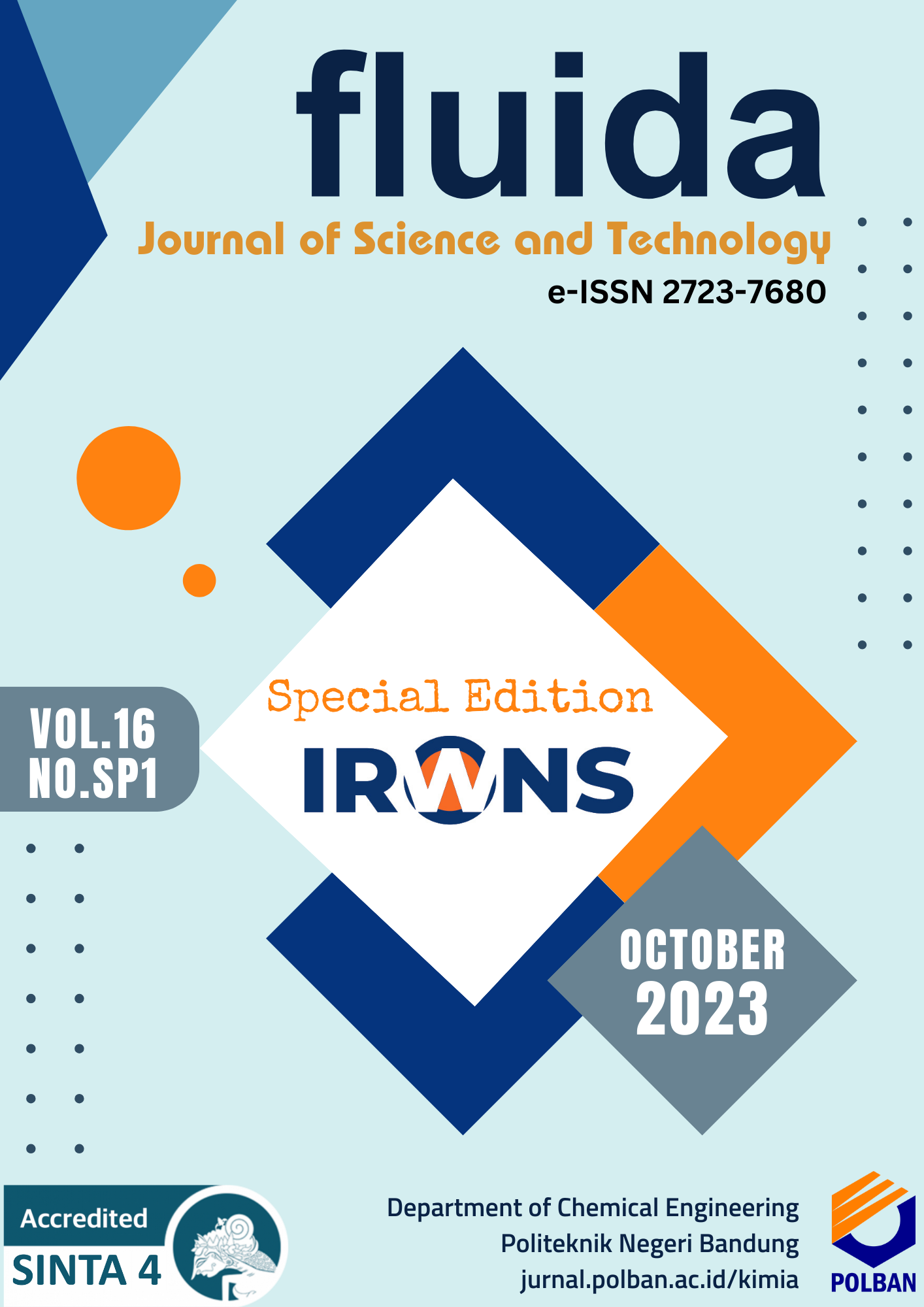Potential of Reducing CO2 Emission Using Parabolic Trough Collector for 13.75MW Desalination Processes
Main Article Content
Abstract
Desalination is an important process in fulfilling the freshwater demands of both the industrial sector and human needs. Typically, thermal desalination processes rely on fossil fuels to minimize production costs. However, using fossil fuel in desalination contributes to releasing CO2 emissions into the atmosphere. Therefore, it is essential to utilize renewable energy sources to mitigate the production of CO2 emissions. To reduce CO2 emissions research has been conducted to explore the potential use of parabolic trough solar collectors in harnessing available solar energy at the power plant site for thermal desalination processes which required 13.75 MW of thermal energy. The study utilized the system advisor model software to assess the collector’s system performance. The research findings indicate that 416 units of parabolic trough solar collectors are required to fulfill the thermal power needs. The presence of these solar collectors has the potential to generate 26.06 GWh of thermal power, thereby reducing coal consumption by 5,740.4 metric tons per year and directly lowering CO2 emissions by 13,892 metric tons per year.
Downloads
Article Details

This work is licensed under a Creative Commons Attribution-ShareAlike 4.0 International License.
An author who publishes in the FLUIDA journal agrees to the following terms:
- Author retains the copyright and grants the journal the right of first publication of the work simultaneously licensed under the Creative Commons Attribution-ShareAlike 4.0 License that allows others to share the work with an acknowledgement of the work's authorship and initial publication in this journal
- Author is able to enter into separate, additional contractual arrangements for the non-exclusive distribution of the journal's published version of the work (e.g., post it to an institutional repository or publish it in a book) with the acknowledgement of its initial publication in this journal.
- Author is permitted and encouraged to post his/her work online (e.g., in institutional repositories or on their website) prior to and during the submission process, as it can lead to productive exchanges, as well as earlier and greater citation of the published work (See The Effect of Open Access).
Read more about the Creative Commons Attribution-ShareAlike 4.0 Licence here: https://creativecommons.org/licenses/by-sa/4.0/.
References
C. Chen, Y. Jiang, Z. Ye, Y. Yang and L. Hou, "Sustainably integrating desalination with solar power to overcome future freshwater scarcity in China," Global Energy Interconnection, no. ScienceDirect, pp. 98-113, 2019.
S. A. Kalogirou, "Seawater desalination using renewable energy sources," Progress in Energy Combustion Science, no. Elsevier, pp. 243-275, 2005.
V. Belessiotis, S. Kalogirou and E. Delyannis, Thermal Solar Desalination: Methods and System, London: Elsevier, 2016.
B. Anand, R. Shankar, S. Murugavelh, W. Rivera, K. M. Prasad and R. Nagarajan, "A review on solar photovoltaic thermal integrated," Renewable and Sustainable Energy Reviews, no. Elsevier, 2021.
Y. Ghalavand, M. S. Hatamipour and A. Rahimi, "A review on energy consumption of desalination," Desalination and Water Treatment, no. Taylor & Francis, 2014.
A. Al-Othman, M. Tawalbeh, M. E. H. Assad, T. Alkayalli and A. Elsa, "Novel multi-stage flash (MSF) desalination plant driven by parabolic trough," Desalination, no. Elsevier, pp. 237-244, 2018.
T. Mezher, H. Fath, Z. Abbas and A. Khaled, "Techno-economic assessment and environmental impacts of," Desalination, no. Elsevier, pp. 263-273, 2011.
Kementerian Lingkungan Hidup dan Kehutanan Republik Indonesia, "Laporan Inventarisasi Gas Rumah Kaca (GRK) dan Monitoring, Pelaporan, Verifikasi (MPV)," KLHK RI, Jakarta, 2021.
Kementerian Energi dan Sumber Daya Mineral Republik Indonesia, "esdm.go.id," KESDM RI, 31 January 2023. [Online]. Available: https://www.esdm.go.id/id/berita-unit/direktorat-jenderal-ketenagalistrikan/capaian-kinerja-subsektor-ketenagalistrikan-infrastruktur-kendaraan-listrik-dan-penurunan-emisi-pembangkit-lampaui-target. [Accessed January 2023].
Kementerian Energi dan Sumber Daya Mineral Republik Indonesia, "esdm.go.id," KESDM RI, 24 February 2020. [Online]. Available: https://ebtke.esdm.go.id/post/2020/02/26/2486/keren.indonesia.power.kini.gunakan.panel.surya.di.wilayah.operasi. [Accessed January 2023].
Perusahaan Listrik Negara, PT PLN (Persero), "web.pln.co.id," PT PLN (Persero), 21 August 2022. [Online]. Available: https://web.pln.co.id/cms/media/2022/08/pln-gelar-pelatihan-cofiring-biomassa-olah-sampah-jadi-bahan-bakar-pltu-tarahan/. [Accessed January 2023].
Kementerian Energi dan Sumber Daya Mineral Republik Indonesia, "esdm.go.id," KESDM RI, 19 June 2012. [Online]. Available: https://www.esdm.go.id/id/media-center/arsip-berita/matahari-untuk-plts-di-indonesia. [Accessed January 2023].
N. A. Moharram, S. Bayoumi, A. A. Hanafy and W. M. El-Maghlany, "Hybrid desalination and power generation plant utilizing," Case Studies in Thermal Engineering, no. Elsevier, 2021.
M. Mehos, H. Price, R. Cable, D. Kearney, B. Kelly, G. Kolb and F. Morse, "Concentrating Solar Power Best Practice Study," National Renewable Energy Laboratory, Colorado, 2020.
S. A. Kalogirou, "A Detailed Thermal Model of a Parabolic Trough Collector Receiver," Energy, pp. 298-306, 2012.
M. Alguacil, C. Prieto, A. Rodiguez and J. Lohrl, "Direct steam generation in parabolic trough collectors," Energy Procedia, no. ScienceDirect, pp. 21-29, 2014.
T. Stoffel, D. Renne, D. Myers, S. Wilcox, M. Sengupta, R. George and C. Turchi, Concentrating Solar Power : Best Practice Handbook for the Collection and Use of Solar Resource Data, Colorado: National Renewable Energy Laboratory, 2010.
A. Boretti, J. Nayfeh and W. Al-Kouz, "Validation of SAM Modelling of Concentrated Solar Power Plant," Energies, p. 1949, 2020.
M. J. Wagner and P. Gilman, "Technical Manual for the SAM Physical Trough Model," National Renewable Energy Laboratory, Colorado, 2011.
I. H. Yilmaz and A. Mwesigye, "Modeling, simulation and performance analysis of parabolic trough collectors: A comprehensive review," Applied Energy 225 (2018), no. Elsevier, pp. 135-174, 2018.
J. A. Duffie and W. A. Beckman, Solar Engineering of Thermal Processes, New Jersey: John Wiley & Sons, 2013.

